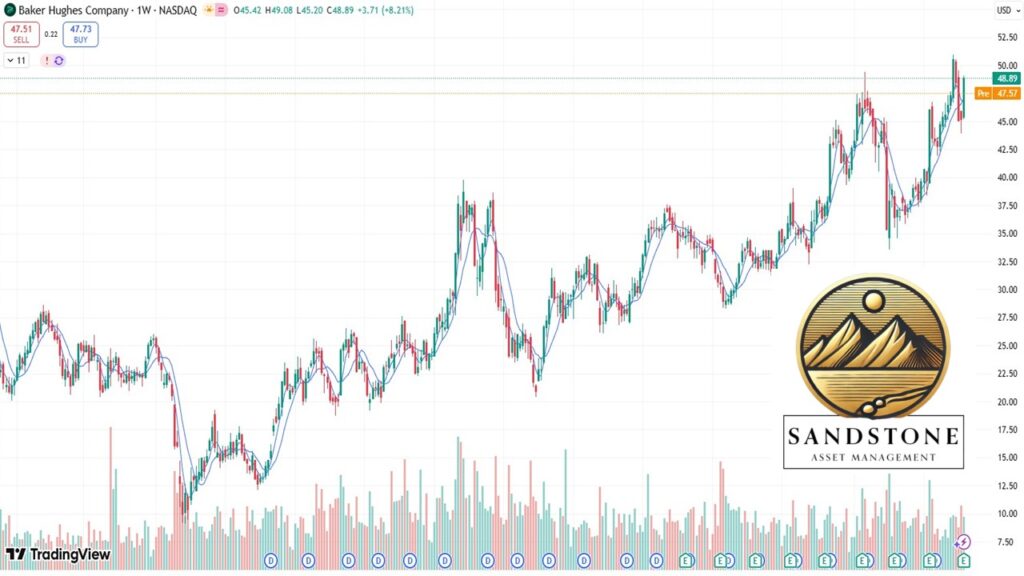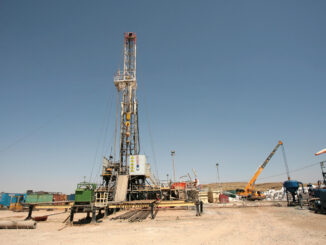
Baker Hughes Company (NASDAQ: BKR), a leading energy technology firm, reported robust third-quarter 2025 results today, underscoring its strategic pivot toward high-growth areas like liquefied natural gas (LNG) and energy transition technologies amid a softening oilfield services environment. Total revenue reached $7.0 billion, marking a modest 1% increase both sequentially and year-over-year, while adjusted earnings per share (EPS) climbed 9% from the prior quarter to $0.68.
The quarter’s standout feature was a surge in orders to $8.2 billion—up 17% sequentially and 23% year-over-year—fueled by record bookings in the Industrial & Energy Technology (IET) segment. With remaining performance obligations (RPO) hitting $35.3 billion, the company affirmed its full-year orders guidance, projecting a beat on prior midpoint estimates after securing nearly $11 billion in the first nine months.
These figures arrive at a pivotal moment for the energy sector, as Brent crude oil prices hover above $80 per barrel and LNG spot prices in Asia and Europe show upward momentum, driven by winter demand and geopolitical supply constraints. For investors eyeing Baker Hughes, the results signal resilience in a bifurcated market: strength in LNG and power generation offsetting headwinds in traditional oilfield services.
Financial Snapshot: Steady Growth with Margin Expansion
Baker Hughes delivered adjusted EBITDA of $1.24 billion, a 2% rise both sequentially and year-over-year, with consolidated margins improving thanks to IET’s outperformance.
GAAP diluted EPS stood at $0.61, while adjusted net income rose 9% sequentially to $678 million. Cash generation remained solid, with operating cash flow at $929 million (up 82% from Q2) and free cash flow at $699 million, supporting $230 million in capital expenditures. Orders and backlog metrics painted an optimistic picture. The book-to-bill ratio of 1.2x across the company—and specifically in IET—highlights sustained demand visibility. IET’s RPO swelled to a record $32.1 billion, up 3% sequentially, including $11.8 billion in Gas Technology Equipment and $15.7 billion in Services.
This backlog provides a multi-year revenue buffer, particularly valuable as energy markets navigate volatility.
Segment Deep Dive: IET Shines, OFSE Faces Macro Pressures
The IET segment, which encompasses gas technology, industrial solutions, and climate technologies, emerged as the quarter’s hero. Revenue grew 2% sequentially and 15% year-over-year to $3.4 billion, propelled by a 26% YoY surge in Gas Technology to $2.5 billion (Equipment up 32%, Services up 15%).
Orders here totaled $4.1 billion— the third time in company history exceeding this threshold—driven by major LNG awards, including gas turbines and compressors for NextDecade’s Rio Grande LNG Train 4, Sempra’s Port Arthur Phase 2 Trains 3-4, and a Middle East NGL facility.
Additional wins spanned offshore FPSOs in South America, 25 aeroderivative gas turbines for North American oil & gas power, and aftermarket services for bp’s Tangguh LNG and Pembina Pipeline. New energy highlights included ORC equipment for Fervo’s 300 MW geothermal project and turbomachinery for a 1.4 million metric ton low-carbon ammonia plant.EBITDA in IET jumped 9% sequentially to $635 million, with margins expanding 1 percentage point to 18.8%, benefiting from volume growth, pricing power, and favorable foreign exchange.
In contrast, the Oilfield Services & Equipment (OFSE) segment grappled with broader macroeconomic challenges. Revenue dipped 8% year-over-year to $3.6 billion (up 1% sequentially), with North America providing a bright spot at $980 million (up 6% from Q2) amid resilient U.S. land activity.
International revenue, however, declined 1% sequentially. Orders rose 16% from Q2 to $4.1 billion, boosted by subsea systems for Turkey’s Sakarya Gas Field and Petrobras’ all-electric completions, but EBITDA fell 12% YoY to $671 million, with margins contracting to 18.5% due to weakness in well construction (-9% YoY), completions (-6% YoY), and subsea (-16% YoY). Geographic drags included Latin America (-7% YoY) and Europe/CIS/Sub-Saharan Africa (-36% YoY).
Strategic Moves: Bolstering the Portfolio for Future GrowthBaker Hughes isn’t standing still. The company announced an intent to acquire Chart Industries for $13.6 billion, a move aimed at enriching its presence in high-growth markets like LNG liquefaction, hydrogen, and clean power.
This deal would enhance value in critical areas, building on the recent completion of the Continental Disc Corporation acquisition, which adds margin-accretive flow and pressure control technologies with strong lifecycle revenues. These steps align with CEO Lorenzo Simonelli’s “Horizon Two” strategy, positioning Baker Hughes as a more diversified player since its 2017 merger.Simonelli emphasized the company’s transformation: “We have fundamentally changed the way we operate, and today Baker Hughes is in the strongest position since the merger nearly a decade ago.”
He highlighted “continued momentum from our Business System deployment, positive trends in Gas Technology, and strong outperformance in U.S. land,” while noting IET’s resilience amid OFSE margin softening from the “broader macro backdrop.”
Analysis: Navigating a Rising Tide in LNG and Oil
Baker Hughes’ Q3 results reflect a company increasingly insulated from oil price cyclicality through its IET exposure. With LNG demand projected to grow 3-4% annually through 2030—fueled by Asia’s energy security needs and Europe’s quest for alternatives to Russian pipeline gas—the segment’s record backlog offers a compelling moat.
Tailwinds in power generation and offshore further reinforce this, as noted by Simonelli: “We also continue to benefit from strong market tailwinds in LNG, power generation, and offshore.”
The forward-looking statements underscore risks like crude oil/natural gas price volatility, OPEC policies, and geopolitical tensions (e.g., Middle East conflicts), but the IET momentum suggests these are manageable.
For OFSE, the quarter’s softness signals caution, but rising oil prices could catalyze a rebound. Higher Brent levels incentivize exploration and production (E&P) spending, particularly in international basins where Baker Hughes has deep ties (e.g., Aramco coiled tubing awards). U.S. land leverage remains a key advantage, with production-related activity providing a buffer against drilling slowdowns.
Overall, the results validate Baker Hughes’ portfolio shift: IET now accounts for nearly half of revenue but drives the majority of growth and margins, reducing reliance on volatile OFSE cycles.

Investor Takeaways: Eyes on LNG Momentum and Oil-Driven Recovery
With LNG and oil prices on an upward trajectory—LNG futures up 15% year-to-date and WTI gaining 10% in Q3—investors should monitor several levers for Baker Hughes:IET Order Intake and Backlog Execution: Track Q4 awards for continued LNG/power wins; sustained book-to-bill above 1.0x could signal multi-year EPS accretion from the Chart deal.
OFSE Margin Trajectory: Watch for oil price passthrough to E&P capex; sequential international revenue stabilization would indicate bottoming.
M&A Integration: Post-close progress on Chart and Continental Disc could unlock synergies, targeting 20%+ EBITDA margins in new verticals.
Macro Sensitivities: Geopolitical flares or OPEC cuts could amplify upside, but inflation/tariffs pose downside risks to costs.
|
Key Metric
|
Q3 2025
|
QoQ Change
|
YoY Change
|
Investor Watch
|
|---|---|---|---|---|
|
Revenue
|
$7.0B
|
+1%
|
+1%
|
IET vs. OFSE split for growth balance
|
|
Adj. EPS
|
$0.68
|
+9%
|
+3%
|
Margin expansion from pricing/FX
|
|
Orders
|
$8.2B
|
+17%
|
+23%
|
LNG-related bookings for visibility
|
|
IET RPO
|
$32.1B
|
+3%
|
N/A
|
Durability in energy transition
|
|
OFSE EBITDA Margin
|
18.5%
|
-0.3 pts
|
-0.8 pts
|
Oil price linkage to recovery
|






Be the first to comment